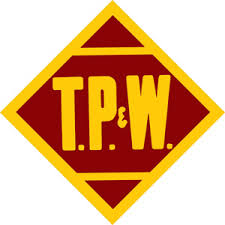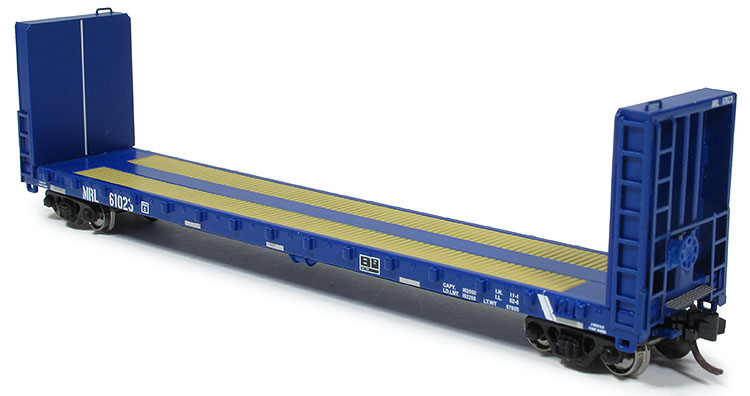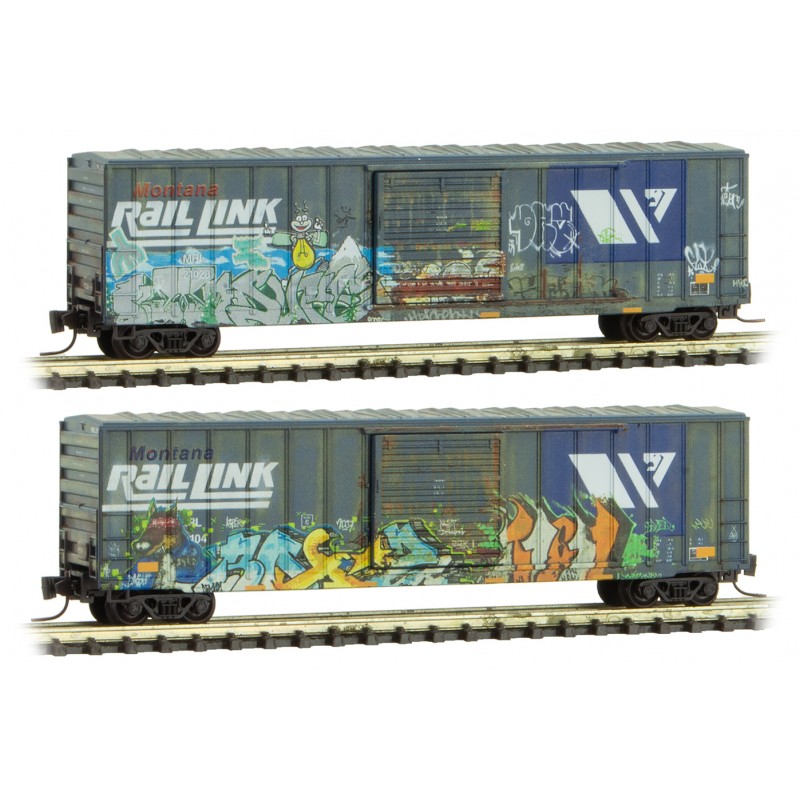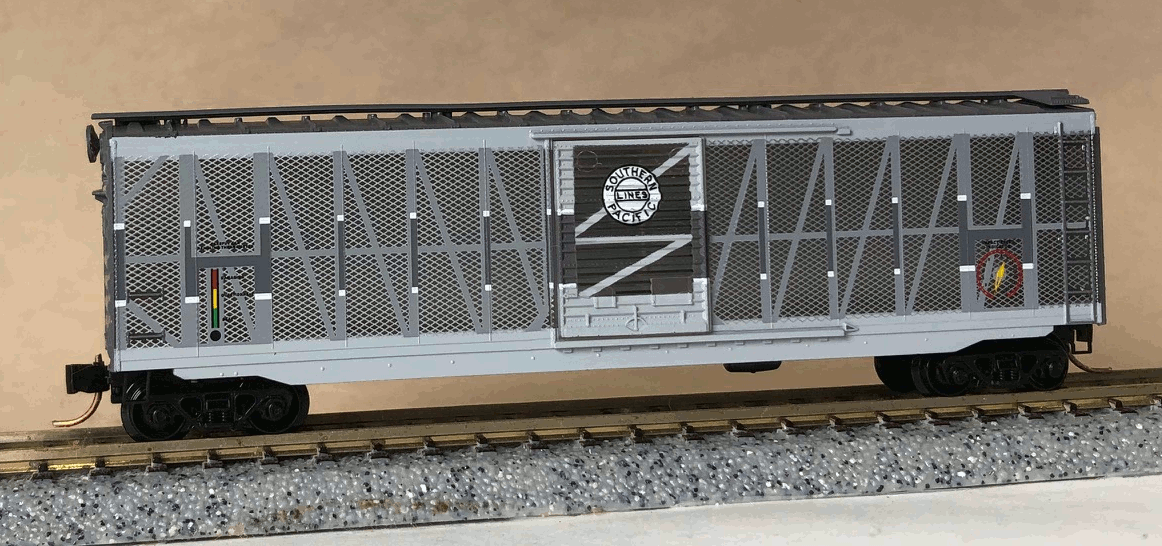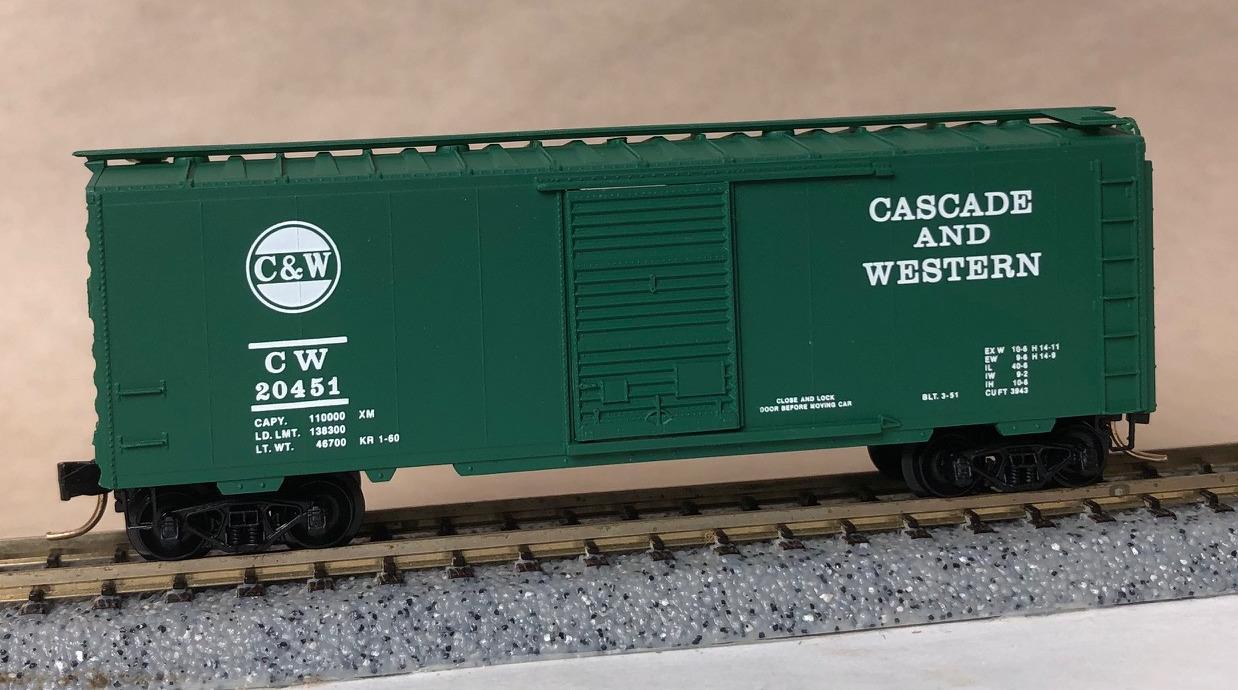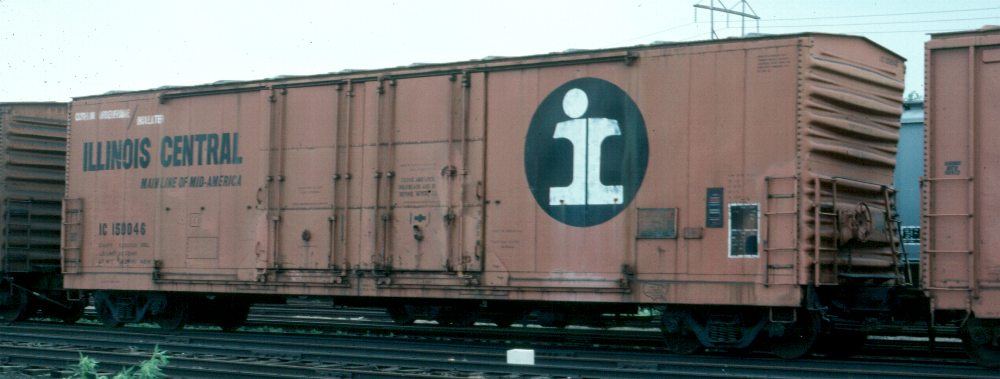Body Style Information: Features: 70-ton roller-bearing trucks;
Blackened metal wheels;
Two-piece underframe;
Separate brake cylinder;
Air reservoir;
End platforms;
AccuMate® couplers.
Prototype Information: This 53' boxcar was manufactured in the 1960s and '70s by Evans Company and was used primarily to haul produce, wood and paper products, and canned goods. This railcar is an insulated RBL (Railcar, Passenger Service, Insulated) featuring a 16 foot opening and double plug doors.
Road/Company Information: TP&W first appeared under that name in 1887. For most of its history, the TP&W ran east and west from Peoria, Illinois, to Keokuk, Iowa on the west bank of the Mississippi River on one end and Effner just on the other side of the Illinois-Indiana state line. There were a couple of short branches on the west end of the line.
TP&W first attracted national attention in 1887 when a passenger excursion train wrecked in Chatsworth, Illinois. The double headed train originated in Peoria and was packed with excursionists headed for Niagara Falls (via connections.) The train was running at speed when it approached a low trestle that had been weakened by a prairie fire. The trestle was only about 15’ high. The lead locomotive made it across and the second engine plunged through it, bringing the train of wooden coaches to an instant halt. At least one of the coaches was telescoped by another. 85 were killed and hundreds injured.
In 1941, TP&W backed out of national labor negotiations over a pay increase that was being considered. TP&W instead pushed for hourly wages and loosening of work rule restrictions. The unions struck and with the outbreak of war, operations were taken over by the Federal Government. After the war, the government handed the operation back to the owner George McNear and the labor strike resumed. In 1947 McNear was assassinated by a striker and that was that. The railroad was sold and operation resumed.
In addition to the local traffic they generated across central Illinois, TP&W served as a bridge route between the Santa Fe at Lomax, Illinois near the west end and the Pennsylvania at Effner, Indiana on the east end. Santa Fe and Pennsy’s only direct connection was in Chicago with all of Chicago’s inherent congestion. Many traffic managers preferred to route through Peoria. For Santa Fe and Pennsylvania, that meant routing over the TP&W.
In the steam era, the kings of the TP&W were a group of six 4-8-4 Northerns purchased in 1937. These Alco’s were the smallest 4-8-4’s on the continent. The diesel era was dominated by Alco and EMD road switchers with a splash of F’s and Lima-Hamilton switchers (these were later replaced by SW1500’s.)
In 1960, the Minneapolis & St. Louis attempted to gain control of the TP&W as well as Monon. M&St.L was also a funnel for the Peoria Gateway and thought the TP&W a good addition. However, when Santa Fe and Pennsy got wind of M&St.L’s stock purchases, the Santa Fe put out their own buy order and quickly grabbed control away from M&St.L. Santa Fe then sold a 50% stake in the TP&W to the Pennsylvania.
In 1970, TP&W suffered a wreck in Crescent City, Illinois. A string of propane tank cars was involved. One of the cars caught fire. As it burned, it boiled the propane in the adjacent car. Eventually the pressure of the boiling fuel exceeded the strength of the fire weakened shell of the tank and it exploded. The cycle started again with the next car. The fire department had successfully evacuated Crescent City but was powerless to fight the fire as burning propane rained down on the town. Crescent City was all but destroyed and the accident led the FRA to set standards on track quality with power to embargo traffic from lines that fell below certain maintenance levels.
The creation of Conrail in 1976 changed traffic patterns for the TP&W. Bridge traffic to the Santa Fe began to dry up. TP&W bought the ex-PRR line from Effner to Logansport, Indiana and a new connection to N&W was established. This brought the TP&W mileage to just over 300 making it about the size of Ann Arbor.
In 1979 the corporate successor of Penn Central sold their half of the TP&W to Santa Fe. At the end of 1983, TP&W was merged into the Santa Fe. In 1986, 33 miles of former TP&W line toward the west end were sold to Keokuk Junction Rwy. But the story didn’t end there.
In 1989, the TP&W lines were spun off by Santa Fe to a group of investors and the TP&W was reborn. The 1995 BNSF merger brought trackage rights for TP&W over the former CB&Q from Peoria northwest to Galesburg. A year later, TP&W was purchased by Delaware Otsego Corporation who also owned the New York Susquehanna & Western and a few shortlines in the New York – Pennsylvania – New Jersey area. During DO ownership, a typical day saw 165 cars move on the line. In 1999, the RailAmerica shortline group made an offer for the TP&W that DO couldn’t refuse and that September, the sale was closed. In 2004, the lines west of Peoria were sold to Keokuk Junction with TP&W continuing with the routes east. In 2012, all of the RailAmerica roads, TP&W included, joined the Genesee & Wyoming shortline group.
TP&W first attracted national attention in 1887 when a passenger excursion train wrecked in Chatsworth, Illinois. The double headed train originated in Peoria and was packed with excursionists headed for Niagara Falls (via connections.) The train was running at speed when it approached a low trestle that had been weakened by a prairie fire. The trestle was only about 15’ high. The lead locomotive made it across and the second engine plunged through it, bringing the train of wooden coaches to an instant halt. At least one of the coaches was telescoped by another. 85 were killed and hundreds injured.
In 1941, TP&W backed out of national labor negotiations over a pay increase that was being considered. TP&W instead pushed for hourly wages and loosening of work rule restrictions. The unions struck and with the outbreak of war, operations were taken over by the Federal Government. After the war, the government handed the operation back to the owner George McNear and the labor strike resumed. In 1947 McNear was assassinated by a striker and that was that. The railroad was sold and operation resumed.
In addition to the local traffic they generated across central Illinois, TP&W served as a bridge route between the Santa Fe at Lomax, Illinois near the west end and the Pennsylvania at Effner, Indiana on the east end. Santa Fe and Pennsy’s only direct connection was in Chicago with all of Chicago’s inherent congestion. Many traffic managers preferred to route through Peoria. For Santa Fe and Pennsylvania, that meant routing over the TP&W.
In the steam era, the kings of the TP&W were a group of six 4-8-4 Northerns purchased in 1937. These Alco’s were the smallest 4-8-4’s on the continent. The diesel era was dominated by Alco and EMD road switchers with a splash of F’s and Lima-Hamilton switchers (these were later replaced by SW1500’s.)
In 1960, the Minneapolis & St. Louis attempted to gain control of the TP&W as well as Monon. M&St.L was also a funnel for the Peoria Gateway and thought the TP&W a good addition. However, when Santa Fe and Pennsy got wind of M&St.L’s stock purchases, the Santa Fe put out their own buy order and quickly grabbed control away from M&St.L. Santa Fe then sold a 50% stake in the TP&W to the Pennsylvania.
In 1970, TP&W suffered a wreck in Crescent City, Illinois. A string of propane tank cars was involved. One of the cars caught fire. As it burned, it boiled the propane in the adjacent car. Eventually the pressure of the boiling fuel exceeded the strength of the fire weakened shell of the tank and it exploded. The cycle started again with the next car. The fire department had successfully evacuated Crescent City but was powerless to fight the fire as burning propane rained down on the town. Crescent City was all but destroyed and the accident led the FRA to set standards on track quality with power to embargo traffic from lines that fell below certain maintenance levels.
The creation of Conrail in 1976 changed traffic patterns for the TP&W. Bridge traffic to the Santa Fe began to dry up. TP&W bought the ex-PRR line from Effner to Logansport, Indiana and a new connection to N&W was established. This brought the TP&W mileage to just over 300 making it about the size of Ann Arbor.
In 1979 the corporate successor of Penn Central sold their half of the TP&W to Santa Fe. At the end of 1983, TP&W was merged into the Santa Fe. In 1986, 33 miles of former TP&W line toward the west end were sold to Keokuk Junction Rwy. But the story didn’t end there.
In 1989, the TP&W lines were spun off by Santa Fe to a group of investors and the TP&W was reborn. The 1995 BNSF merger brought trackage rights for TP&W over the former CB&Q from Peoria northwest to Galesburg. A year later, TP&W was purchased by Delaware Otsego Corporation who also owned the New York Susquehanna & Western and a few shortlines in the New York – Pennsylvania – New Jersey area. During DO ownership, a typical day saw 165 cars move on the line. In 1999, the RailAmerica shortline group made an offer for the TP&W that DO couldn’t refuse and that September, the sale was closed. In 2004, the lines west of Peoria were sold to Keokuk Junction with TP&W continuing with the routes east. In 2012, all of the RailAmerica roads, TP&W included, joined the Genesee & Wyoming shortline group.
Brand/Importer Information: In 1924 Stephan Schaffan, Sr. founded the Atlas Tool Company in Newark, New Jersey. In 1933 his son, Stephan Schaffan, Jr., came to work for his father at the age of sixteen. Steve Jr. built model airplanes as a hobby and frequented a local hobby shop. Being an enterprising young man, he would often ask the owner if there was anything he could do to earn some extra spending money. Tired of listening to his requests, the hobby-store owner threw some model railroad track parts his way and said, "Here, see if you can improve on this".
Atlas has made a ton of wonderful products throughout the years and we often get questions one whether we have run a certain road name on a particular model. It should be noted that Atlas locomotives and rolling stock are greatly appreciated for their superior operating and running characteristics. Atlas products are also well known for their outstanding collectability not only due to their superior prototypical workmanship, details and decoration, but because there are relatively so few of them made. Each and every production run has been carefully built to market demand, meaning almost every piece in any given run is sold out by Atlas on arrival or shortly thereafter, thus creating a built in collectors market.
Atlas has made a ton of wonderful products throughout the years and we often get questions one whether we have run a certain road name on a particular model. It should be noted that Atlas locomotives and rolling stock are greatly appreciated for their superior operating and running characteristics. Atlas products are also well known for their outstanding collectability not only due to their superior prototypical workmanship, details and decoration, but because there are relatively so few of them made. Each and every production run has been carefully built to market demand, meaning almost every piece in any given run is sold out by Atlas on arrival or shortly thereafter, thus creating a built in collectors market.
Item created by: devsummers428 on 2020-01-19 14:56:42. Last edited by devsummers428 on 2020-05-07 00:00:00
If you see errors or missing data in this entry, please feel free to log in and edit it. Anyone with a Gmail account can log in instantly.
If you see errors or missing data in this entry, please feel free to log in and edit it. Anyone with a Gmail account can log in instantly.




